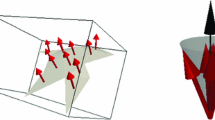Abstract
This work focuses on the simulation of mechanical contact between nonlinearly elastic objects, such as the components of the human body. In traditional methods, contact forces are often defined as discontinuous functions of deformations, which leads to poor convergence characteristics and high-frequency noises. We introduce a novel penalty method for finite-element simulation based on the concept of material depth, which is the distance between a particle inside an object and the object’s boundary. By linearly interpolating precomputed material depths at node points, contact forces can be analytically integrated over contact surfaces without raising the computational cost. The continuity achieved by this formulation reduces oscillation and artificial acceleration, resulting in a more reliable simulation algorithm.
Similar content being viewed by others
References
Anderson P et al (1999) Using Maya. Alias|Wavefront
Baraff D, Witkin A (1992) Dynamic simulation of non-penetrating flexible bodies. In: Proceedings of the 19th annual conference on computer graphics and interactive techniques. ACM Press, New York
Baraff D, Witkin A (1998) Large steps in cloth simulation. In: Proceedings of the 25th annual conference on computer graphics and interactive techniques. ACM Press, New York
Belytschko T, Neal MO (1991) Contact impact by the pinball algorithm with penalty and Lagrangian methods. Int J Numer Methods Eng 31:547–572
Belytschko T, Yeh I-S (1992) The splitting pinball method for general contact. In: Glowinksi R (ed) Computing methods in applied science and engineering. Nova Science, New York
Benson DJ, Hallquist JO (1990) A single surface contact algorithm for the post-buckling analysis of shell structures. Comput Methods Appl Mech Eng 78:141–163
Bonet J, Wood RD (1997) Nonlinear continuum mechanics for finite element analysis. Cambridge University Press, New York
Bridson R, Fedkiw R, Anderson J (2002) Robust treatment of collisions, contact and friction for cloth animation. In: Proceedings of the 29th annual conference on computer graphics and interactive techniques. ACM Press, New York
Brown K, Attaway S, Plimpton S, Hendrickson B (2000) Parallel strategies for crash and impact simulations. Comput Methods Appl Mech Eng 184:375–390
Carstensen C, Scherf O, Wriggers P (1999) Adaptive finite elements for elastic bodies in contact. SIAM J Sci Comput 20(5):1605–1626.
Gourret J-P, Thalmann NM, Thalmann D (1989) Simulation of object and human skin deformations in a grasping task. In: Proceedings of the 16th annual conference on computer graphics and interactive techniques. ACM Press, New York
Heinstein MW, Attaway SW, Swegle JW, Mello FJ (1993) A general-purpose contact detection algorithm for nonlinear structural analysis codes. Sandia Report, SAND92-2141 UC-705. Sandia National Laboratories Technical Library, Albuquerque, New Mexico
Heinstein MW, Attaway SW, Swegle JW, Mello FJ (1993), A general contact detection algorithm for finite element analysis. In: Aliabadi MH, Brebbia C A (eds) Contact mechanics. Computational Mechanics Publications, Southampton, UK
Hirota G, Fisher S, State A, Fuchs H, Lee C (2001) Simulation of deforming elastic solids in contact. SIGGRAPH Technical Sketch. In: SIGGRAPH 2001 conference abstracts and applications. ACM Press, New York
Hirota G, Fisher S, State A, Fuchs H, Lee C (2001) An implicit finite element method for elastic solids in contact In: Computer Animation 2001, Seoul, Korea, 7–8 November 2001
Hirota G (2002) An improved finite element contact model for anatomical simulations. PhD thesis, Department of Computer Science, University of North Carolina at Chapel Hill
Lin JI (1998) DYNA3D: a nonlinear, explicit, three-dimensional finite element code for solid and structural mechanics. User manual, Methods Development Group, Lawrence Livermore National Laboratory
Malcolm LL (1976) An experimental investigation of the frictional and deformational response of articular cartilage interfaces to statistic and dynamic loading. PhD thesis, University of California San Diego
Marcum DL, Weatherill NP (1995) Unstructured grid generation using iterative point insertion and local reconnection. AIAA J 33(9):1619–1625
Miller K, Chinzei K, Orssengo G, Bednarz P (2000) Mechanical properties of brain tissue in-vivo: experiment and computer simulation. J Biomechanics 33:1369–1376
Moro-oka T, Miura H, Higaki H, Arimura S, Mawatari T, Murakami T, Iwamoto Y (1999) A new friction tester of the flexor tendon. J Biomechanics 32:1131–1134
O’Brien JF, Hodgins JK (1999) Graphical modeling and animation of brittle fracture. In: Proceedings of the 26th annual conference on computer graphics and interactive techniques. ACM Press, New York
Padmanabhan V, Laursen TA (1998) A new contact surface smoothing procedure for the implicit finite element analysis of frictional contact. In: Guran A (ed) Proceedings of the first international symposium on impact and friction of solids, structures and intelligent machines, Ottawa, Canada, 27–30 June 1998. Series on stability, vibration and control of systems, series B, vol 14. World Scientific, Singapore
Papadopoulos P, Taylor RL (1993) A simple algorithm for three-dimensional finite element analysis of contact problems. Comput Struct 46(6):1107–1118
Puso MA, Laursen TA (2001) A 3D contact smoothing method using Gregory patches. Int J Numer Methods Eng (under review)
Richtmyer RD, Morton LW (1967) Difference methods for initial-value problems. Interscience, New York
Spitzer V, Ackermann MJ, Scherzinger AL, Whitlock D (1996) The visible human male: A technical report. J Am Med Inform Assoc 3(2):118–130
Terzopoulos D, Platt J, Barr A, Fleischer K (1987) Elastically deformable models. In: ACM Press, New York
Zhuang Y (2000) Real-time simulation of physically-realistic global deformations. PhD thesis, Department of Electrical Engineering and Computer Science, University of California, Berkeley
Author information
Authors and Affiliations
Corresponding author
Rights and permissions
About this article
Cite this article
Hirota, G., Fisher, S. & State, A. An improved finite-element contact model for anatomical simulations. Vis Comput 19, 291–309 (2003). https://doi.org/10.1007/s00371-002-0188-5
Published:
Issue Date:
DOI: https://doi.org/10.1007/s00371-002-0188-5




